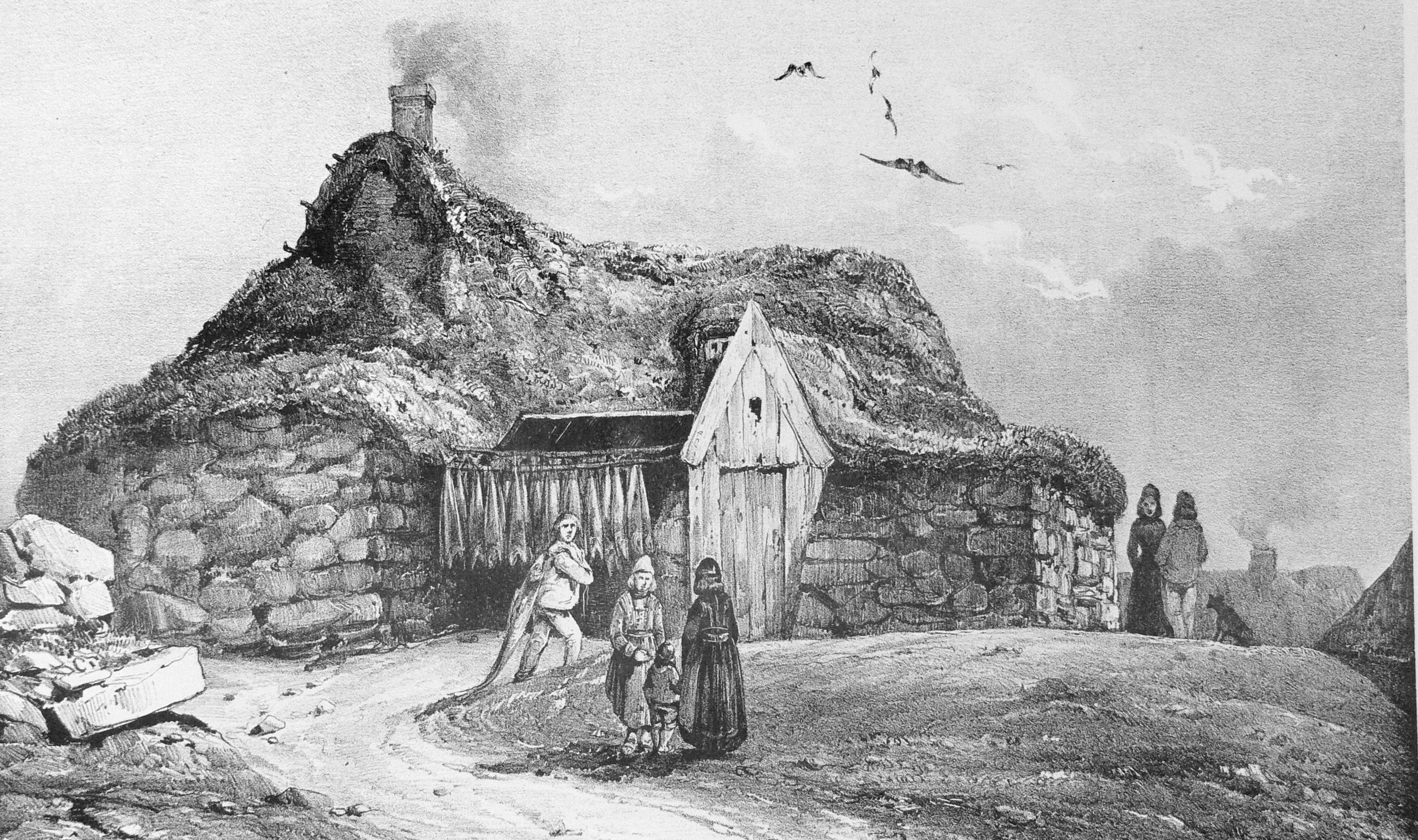|
Skyr
Skyr ( ; ) is an Icelandic cultured dairy product originating in Norway. It has the consistency of strained yogurt, but a milder flavor. Skyr can be classified as a Fresh cheese, fresh sour milk cheese, similar to curd cheese consumed like a yogurt in the Baltic states, Low Countries, the Low Countries, Germany and Russia. It has been a part of Icelandic cuisine for centuries. Skyr has a slightly sour dairy flavor, with a hint of residual sweetness. It is traditionally served cold, either plain or with cream. Commercial manufacturers of skyr have added flavors such as vanilla, coffee, or fruit. History A staple of Icelandic diet since the Viking age, Skyr is mentioned in a number of medieval Icelandic sources, including Egil's saga and Grettis saga. It has been suggested that skyr was known throughout Scandinavia at the time of the settlement of Iceland, but eventually forgotten outside Iceland. The word skyr is related to the English word Wikt:shear#English, ''shear'' (to ... [...More Info...] [...Related Items...] OR: [Wikipedia] [Google] [Baidu] |
Icelandic Cuisine
''Randabrauð'', the cuisine of Iceland, has a long history. Important parts of Icelandic cuisine are lamb, dairy, and fish, the latter due to the fact that Iceland has traditionally been inhabited only near its coastline. Popular foods in Iceland include skyr, hangikjöt (smoked lamb), kleinur, laufabrauð, and bollur. Þorramatur is a traditional buffet served at midwinter festivals called Þorrablót; it includes a selection of traditionally cured meat and fish products served with '' rúgbrauð'' (dense dark and sweet rye bread) and brennivín (an Icelandic akvavit). The flavors of this traditional country food originate in its preservation methods; pickling in fermented whey or brine, drying, and smoking. Modern Icelandic chefs usually emphasise the quality of available ingredients rather than age-old cooking traditions and methods. Numerous restaurants in Iceland specialise in seafood. At the annual Food and Fun chef's competition (held since 2004), competitors c ... [...More Info...] [...Related Items...] OR: [Wikipedia] [Google] [Baidu] |
Yogurt
Yogurt (; , from tr, yoğurt, also spelled yoghurt, yogourt or yoghourt) is a food produced by bacterial fermentation of milk. The bacteria used to make yogurt are known as ''yogurt cultures''. Fermentation of sugars in the milk by these bacteria produces lactic acid, which acts on milk protein to give yogurt its texture and characteristic tart flavor. Cow's milk is the milk most commonly used to make yogurt. Milk from water buffalo, goats, ewes, mares, camels, and yaks are also used to produce yogurt. The milk used may be homogenized or not. It may be pasteurized or raw. Each type of milk produces substantially different results. Yogurt is produced using a culture of ''Lactobacillus delbrueckii'' subsp. ''bulgaricus'' and ''Streptococcus thermophilus'' bacteria. In addition, other lactobacilli and bifidobacteria are sometimes added during or after culturing yogurt. Some countries require yogurt to contain a specific amount of colony-forming units (CFU) of bacteria; in China ... [...More Info...] [...Related Items...] OR: [Wikipedia] [Google] [Baidu] |
Settlement Of Iceland
The settlement of Iceland ( is, landnámsöld ) is generally believed to have begun in the second half of the ninth century, when Norse settlers migrated across the North Atlantic. The reasons for the migration are uncertain: later in the Middle Ages Icelanders themselves tended to cite civil strife brought about by the ambitions of the Norwegian king Harald I of Norway, but modern historians focus on deeper factors, such as a shortage of arable land in Scandinavia. Unlike Great Britain and Ireland, Iceland was unsettled land and could be claimed without conflict with existing inhabitants. On the basis of '' Íslendingabók'' by Ari Þorgilsson, and '' Landnámabók'', histories dating from the twelfth and thirteenth centuries and providing a wealth of detail about the settlement, the years 870 and 874 have traditionally been considered the first years of settlement. However, these sources are largely unreliable in the details they provide about the settlement, and recent rese ... [...More Info...] [...Related Items...] OR: [Wikipedia] [Google] [Baidu] |
New York Times
''The New York Times'' (''the Times'', ''NYT'', or the Gray Lady) is a daily newspaper based in New York City with a worldwide readership reported in 2020 to comprise a declining 840,000 paid print subscribers, and a growing 6 million paid digital subscribers. It also is a producer of popular podcasts such as '' The Daily''. Founded in 1851 by Henry Jarvis Raymond and George Jones, it was initially published by Raymond, Jones & Company. The ''Times'' has won 132 Pulitzer Prizes, the most of any newspaper, and has long been regarded as a national "newspaper of record". For print it is ranked 18th in the world by circulation and 3rd in the U.S. The paper is owned by the New York Times Company, which is publicly traded. It has been governed by the Sulzberger family since 1896, through a dual-class share structure after its shares became publicly traded. A. G. Sulzberger, the paper's publisher and the company's chairman, is the fifth generation of the family to head the p ... [...More Info...] [...Related Items...] OR: [Wikipedia] [Google] [Baidu] |
Egil's Saga
''Egill's Saga'' or ''Egil's saga'' ( non, Egils saga ; ) is an Icelandic saga (family saga) on the lives of the clan of Egill Skallagrímsson (Anglicised as Egill Skallagrimsson), an Icelandic farmer, viking and skald. The saga spans the years c. 850–1000 and traces the family's history from Egill's grandfather to his offspring. Its oldest manuscript (a fragment) dates back to 1240 AD, and comprises the sole source of information on the exploits of Egill, whose life is not historically recorded. Stylistic and other similarities between ''Egill's Saga'' and ''Heimskringla'' have led many scholars to believe that they were the work of the same author, Snorri Sturluson. The work is generally referred to as ''Egla'' by Icelandic scholars. Synopsis The saga begins in Norway around 850, with the life of Egill's grandfather Ulf ( Úlfr) aka Kveldulf or "Evening Wolf", and his two sons Thorolf (Þórólfr) and Skallagrim ( Skalla-Grímr). Strife with the royal house drive the fa ... [...More Info...] [...Related Items...] OR: [Wikipedia] [Google] [Baidu] |
Grettis Saga
''Grettis saga Ásmundarsonar'' (modern , reconstructed ), also known as ''Grettla'', ''Grettir's Saga'' or ''The Saga of Grettir the Strong'', is one of the Icelanders' sagas. It details the life of Grettir Ásmundarson, a bellicose Icelandic outlaw. Overview Grettir's saga is considered one of the Sagas of Icelanders (Íslendingasögur), which were written down in the thirteenth and fourteenth centuries and record stories of events that supposedly took place between the ninth and the eleventh centuries in Iceland. The manuscript of Grettir's saga was written down some time just before 1400 AD, making it a late addition to the tradition.. Introduction. ''The Saga of Grettir the Strong'', p. ix The author is unknown but it is believed that his story may have been based on a previous account of Grettir's life written by Sturla Þórðarson. Whoever the author was, the author shows an awareness of the Sagas of Icelanders tradition by making references to other sagas and bor ... [...More Info...] [...Related Items...] OR: [Wikipedia] [Google] [Baidu] |
Scandinavia
Scandinavia; Sámi languages: /. ( ) is a subregion in Northern Europe, with strong historical, cultural, and linguistic ties between its constituent peoples. In English usage, ''Scandinavia'' most commonly refers to Denmark, Norway, and Sweden. It can sometimes also refer more narrowly to the Scandinavian Peninsula (which excludes Denmark but includes part of Finland), or more broadly to include all of Finland, Iceland, and the Faroe Islands. The geography of the region is varied, from the Norwegian fjords in the west and Scandinavian mountains covering parts of Norway and Sweden, to the low and flat areas of Denmark in the south, as well as archipelagos and lakes in the east. Most of the population in the region live in the more temperate southern regions, with the northern parts having long, cold, winters. The region became notable during the Viking Age, when Scandinavian peoples participated in large scale raiding, conquest, colonization and trading mostly throughout Eu ... [...More Info...] [...Related Items...] OR: [Wikipedia] [Google] [Baidu] |
Fruit
In botany, a fruit is the seed-bearing structure in flowering plants that is formed from the ovary after flowering. Fruits are the means by which flowering plants (also known as angiosperms) disseminate their seeds. Edible fruits in particular have long propagated using the movements of humans and animals in a symbiotic relationship that is the means for seed dispersal for the one group and nutrition for the other; in fact, humans and many animals have become dependent on fruits as a source of food. Consequently, fruits account for a substantial fraction of the world's agricultural output, and some (such as the apple and the pomegranate) have acquired extensive cultural and symbolic meanings. In common language usage, "fruit" normally means the seed-associated fleshy structures (or produce) of plants that typically are sweet or sour and edible in the raw state, such as apples, bananas, grapes, lemons, oranges, and strawberries. In botanical usage, the term "fruit" als ... [...More Info...] [...Related Items...] OR: [Wikipedia] [Google] [Baidu] |
Whey
Whey is the liquid remaining after milk has been curdled and strained. It is a byproduct of the manufacturing of cheese or casein and has several commercial uses. Sweet whey is a byproduct resulting from the manufacture of rennet types of hard cheese, like cheddar or Swiss cheese. Acid whey (also known as sour whey) is a byproduct brought out during the making of acid types of dairy products, such as strained yogurt. Whey proteins consist of α-lactalbumin, β-lactoglobulin, serum albumin, immunoglobulins, and proteose peptones. Composition Whey protein is the collection of globular proteins isolated from whey. The protein in cow's milk is 20% whey protein and 80% casein protein, whereas the protein in human milk is 60% whey and 40% casein. The protein fraction in whey constitutes approximately 10% of the total dry solids in whey. This protein is typically a mixture of beta-lactoglobulin (~48-58%), alpha-lactalbumin (~13-19%), bovine serum albumin (~6%)(see also ser ... [...More Info...] [...Related Items...] OR: [Wikipedia] [Google] [Baidu] |
Protein
Proteins are large biomolecules and macromolecules that comprise one or more long chains of amino acid residues. Proteins perform a vast array of functions within organisms, including catalysing metabolic reactions, DNA replication, responding to stimuli, providing structure to cells and organisms, and transporting molecules from one location to another. Proteins differ from one another primarily in their sequence of amino acids, which is dictated by the nucleotide sequence of their genes, and which usually results in protein folding into a specific 3D structure that determines its activity. A linear chain of amino acid residues is called a polypeptide. A protein contains at least one long polypeptide. Short polypeptides, containing less than 20–30 residues, are rarely considered to be proteins and are commonly called peptides. The individual amino acid residues are bonded together by peptide bonds and adjacent amino acid residues. The sequence of amino acid resid ... [...More Info...] [...Related Items...] OR: [Wikipedia] [Google] [Baidu] |



.png)





